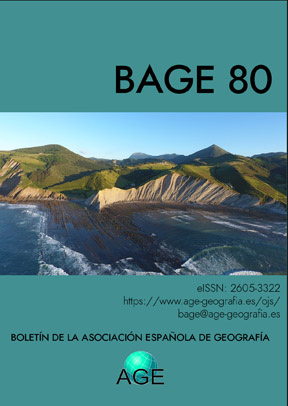Spatial structure of the offshore financial centers in Europe
Main Article Content
Abstract
The spatial network of international corporate connections filtered in the so-called Panama papers has been analysed for the whole of Europe. This has allowed us to know the spatial morphology of the financial structure of capital evasion from Europe to tax havens around the world. It also makes it possible to map financial capital flows in Europe, identifying their points of origin, transit and destination. The result reveals the existence of different financial spaces within the continent, as well as territories outside Europe that are under the geopolitical control of the EU, and which constitute critical nodes as the final destination of capital. The most important by far belongs to the remains of the English colonial empire. It is a space used by the United Kingdom to establish a global financial network with its epicentre in the City and its final destination in the British Virgin Islands.
Downloads
Article Details
References
Aalbers, M B. (2017). Corporate Financialization. In D. Richardson, N. Castree, M. F. Goodchild, A. Kobayashi, W. Liu & R. A. Marston (Eds.), International Encyclopedia of Geography: People, the Earth, Environment and Technology. https://doi.org/10.1002/9781118786352.wbieg0598
Aalbers, M. B. (2016). Financiarización corporativa. Enciclopedia Internacional de Geografía: Gente, la Tierra, Ambiente y Tecnología: Gente, Tierra, Ambiente y Tecnología , 1-11.
Alstadsæter, A., Johannesen, N., & Zucman, G. (2017). Who Owns the Wealth in Tax Havens? Macro Evidence and Implications for Global Inequality. National Bureau of Economic Research.
Asgharian, H., Hess, W., & Liu, L. (2013). A spatial analysis of international stock market linkages. Journal of Banking & Finance, 37(12), 4738–4754.
Butkiewicz, J. L., & Gordon, L. C. (2013). The economic growth effect of offshore banking in host territories: Evidence from the Caribbean. World Development, 44, 165–179.
Coe, N. M., Lai, K. P., & Wójcik, D. (2014). Integrating finance into global production networks. Regional Studies, 48(5), 761–777.
Didier, T., Llovet, R., & Schmukler, S. L. (2017): International financial integration of East Asia and Pacific. Journal of the Japanese and International Economies, 44, 52–66.
Dyreng S. D., & Lindsey, B. P. (2009). Using financial accounting data to examine the effect of foreign operations located in tax havens and other countries on US multinational firms' tax rates. Journal of Accounting Research, 47(5), 1283–1316.
Fernández Cela, J. C. (2015). Estructura espacial de los flujos de Inversión Exterior Directa en España. Primeros pasos para la elaboración de una cartografía financiera. Geopolítica(s), 6(1), 107–136.
Fernández Cela, J. C. (2017). ¿Una geografía de la corrupción? GeocritiQ.
Fernández Cela, J. C. (2018). Geografía financiera y paraísos fiscales. Implicaciones geopolíticas. Boletín IEEE, 9, 268–284.
Garcia-Bernardo, J. et al. (2017). Uncovering Offshore Financial Centers: Conduits and Sinks in the Global Corporate Ownership Network. Scientific Reports, 7(1), 6246.
Corpataux, J., Crevoisier, O., & Theurillat, T. (2017). The territorial governance of the financial industry. In R. Martin & J. Pollard, Handbook on the Geographies of Money and Finance (pp. 69–85). Edward Elgar Publishing.
Geamanu, A., & Dumitrana, M. (2015). Five Regional Perspectives of Constructing an Offshore Corporate Structure. SEA: Practical Application of Science, 7, 251–262.
Giegold, S. (2017). How Luxembourg resisted European tax cooperation and made money with its circumvention. Greens/EFA in the European Parlament. Retrieved from https://www.greens-efa.eu/en/article/news/how-luxembourg-resisted-european-tax-cooperation-and-made-money-with-its-circumvention/
Gutiérrez de Pablo, G. (2015). Análisis jurídico de los paraísos fiscales y medidas para evitar sus efectos (Doctoral dissertation, Universidad de Málaga, Spain). Retrieved from https://riuma.uma.es/xmlui/bitstream/handle/10630/12862/TD_GUTIERREZ_DE_PABLO_Gonzalo.pdf?sequence=1&isAllowed=y
Ibrahim, B. M., Brzeszczynski, J., & Bhattacharjee, A. (2017). Geographical Changes in Influence of Stock Trading Centres Around the 2007 Global Financial Crisis (Financial Geography Working Paper, nº 8). Retrieved from http://www.fingeo.net/wordpress/wp-content/uploads/2017/10/WP8-Geographical-Changes-in-Influence-of-Stock-Trading.pdf
Johannesen, N., Langetieg, P., Reck, D., Risch, M., & Slemrod, J. (2018). Taxing hidden wealth: The consequences of US enforcement initiatives on evasive foreign accounts, nº 24366. National Bureau of Economic Research.
Knight, E., & Wójcik, D. (2017). Geographical linkages in the financial services industry: a dialogue with organizational studies. Regional Studies, 51(1), 116–127.
Martin, R., & Pollard, J. (Eds.) (2017). Handbook on the Geographies of Money and Finance. Edward Elgar Publishing.
Milesi-Ferretti, G. M., Strobbe, F., & Tamirisa, N. T. (2010). Bilateral financial linkages and global imbalances: a view on the eve of the financial crisis.
Muellerleile, C. (2015). Speculative boundaries: Chicago and the regulatory history of US financial derivative markets. Environment and Planning A 47(9), 1805–1823.
OCDE (2017). Plan de acción contra la erosión de la base imponible y el traslado de beneficios, 2014. Retrieved from http://www.aedf-ifa.org/FicherosVisiblesWeb/Ficheros/Fichero79.pdf
Pan, F., Hall, S., & Zhang, H. (2018). The geographies of financial activities within an emerging international financial center: the case of Beijing (Financial Geography Working Paper, nº 10). Retrieved from http://www.fingeo.net/wordpress/wp-content/uploads/2018/01/WP10_The-geographies-of-financial-activities_IFC-Beijing.pdf
Sokol, M. (2013). Towards a “newer” economic geography? Injecting finance and financialisation into economic geographies. Cambridge Journal of Regions, Economy and Society, 6(3), 501–515.
Wójcik, D., Macdonald-Korth, D., & Zhao, S. X. (2017). The political–economic geography of foreign exchange trading. Journal of Economic Geography, 17(2), 267–286.
Zook, M., & Grote, M. H. (2017). The microgeographies of global finance: High-frequency trading and the construction of information inequality. Environment and Planning A: Economy and Space, 49(1), 121–140.
Zucman, G. (2014). La riqueza oculta de las naciones. Barcelona: Pasado y Presente.

